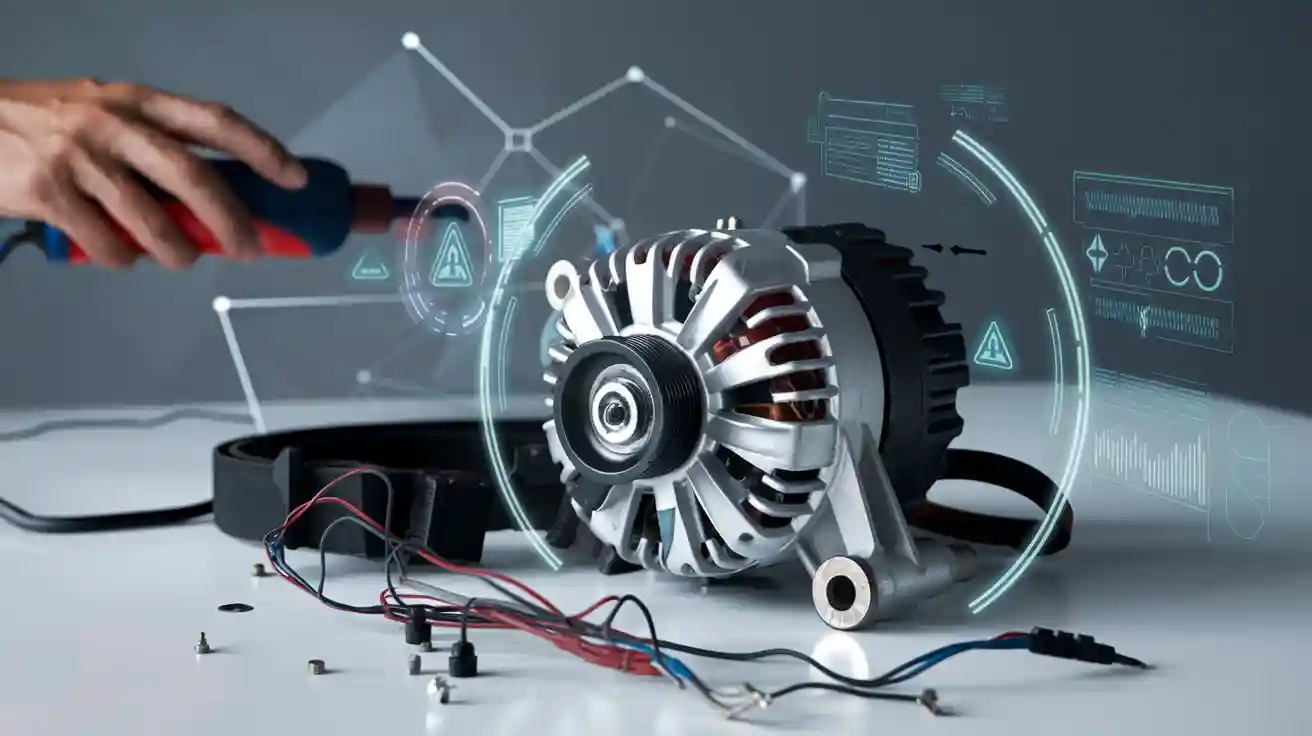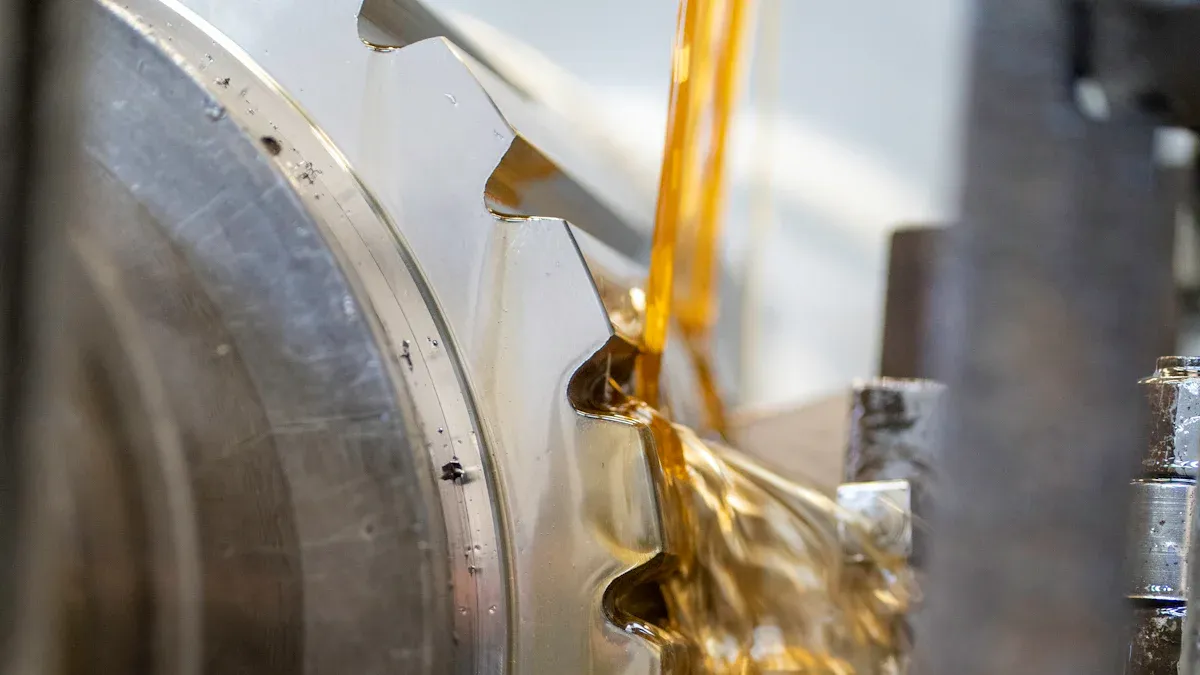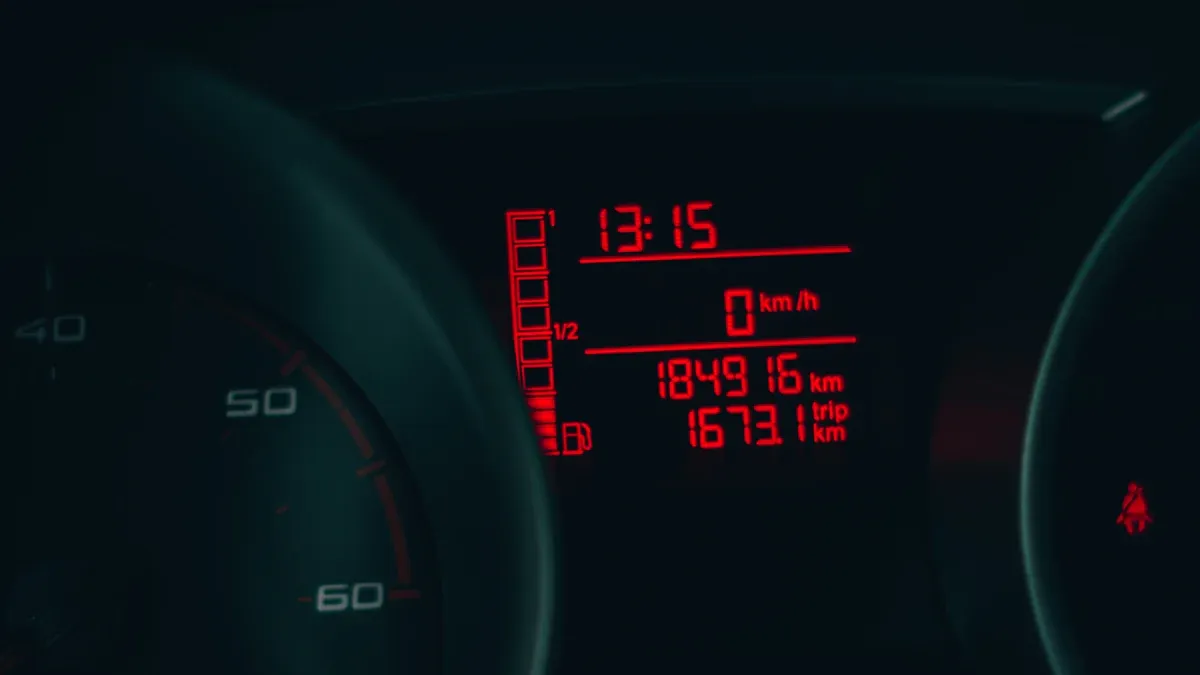
You count on your alternator every time you drive. When it starts to fail, you might notice things like warning lights, dim headlights, or strange noises. Catching these signs early can save you from a big repair bill, sometimes as high as $790.
Regular checks help you avoid sudden breakdowns.
Taking care of car alternators keeps your vehicle running strong.
If you ever swap out an old alternator, remember it still has value. Keep an eye on your car's electrical system and act fast when you spot anything odd.
Causes of Failure

Image Source: pexels
Worn Bearings
Most people do not think about the bearings inside the alternator. These bearings help the alternator spin easily. Heat, dirt, and friction can wear them out over time. When bearings wear out, you might hear grinding or whining sounds. Sometimes, the noise goes away if you take off the serpentine belt. This makes it hard to find the problem. Even if the pulley feels smooth, the bearings might still be bad. If the bearings fail, the alternator stops charging the battery. This can leave you stuck. Checking the alternator and keeping it clean helps stop this from happening.
Tip: Listen for strange sounds and check the belt. Finding bearing problems early can stop a breakdown.
Bad Voltage Regulator
The voltage regulator controls how much power goes to your battery. It acts like a traffic cop for your car’s electricity. If it fails, you may see warning lights or flickering headlights. Sometimes, your battery dies or your engine stalls. The voltage keeps changing and causes problems. Here is a quick chart of what can happen:
Symptom | What It Means |
|---|---|
Battery gets too much or too little charge | |
Flickering or Dim Lights | Unstable voltage affects headlights and dash lights |
Electrical Malfunctions | Electronics act up due to voltage swings |
Engine Performance Issues | Engine may run rough or stall |
A bad voltage regulator can cause many problems. If you see these signs, get your alternator checked soon.
Broken Diodes
Diodes inside the alternator change AC power to DC power. Your car needs DC power to work. If a diode breaks, electricity can leak the wrong way. This drains the battery and causes weird noises. Sometimes, your car will not start after sitting overnight. You might notice your radio or other electronics acting odd. Mechanics use special tools to find broken diodes. If you ignore this, the alternator will not charge the battery right. You could get stuck.
Broken diodes can:
Drain the battery when the car is off
Let AC current in, making electronics act weird
Lower the alternator's charging power
Worn Brushes
Brushes inside the alternator send electricity to moving parts. These brushes wear down over time. When this happens, you may see a battery warning light. Your headlights might dim or flicker. You could have trouble starting your car. Power windows may move slowly. Worn brushes mean the alternator cannot keep up with your car’s needs. If you see these signs, get your alternator checked or replaced.
Headlights or dashboard lights get dim
Battery warning light turns on
Car is hard to start
Power windows move slow or weak
Overheating
Alternators do not like heat. High temperatures or blocked fans can make them too hot. Using lots of electronics can also cause overheating. Short trips add stress because the alternator does not have time to recharge the battery. Overheating hurts the inside parts and makes the alternator wear out faster. To keep it cool, make sure your engine's cooling system works well. Try not to use too many electronics at once.
Note: If your engine gets hot or you use lots of electronics, check your alternator more often.
Contaminants
Dirt, oil, and water are bad for the alternator. These things can block vents and stop air from flowing. This makes the alternator overheat. Oil leaks or road dirt can get inside and wear out the bearings or brushes. Dirty or rusty terminals make it hard for the alternator to send power to the battery. To stop these problems, keep the engine bay clean and check for leaks.
Contaminants can:
Block airflow and cause overheating
Wear out bearings and brushes faster
Make electrical connections worse
A clean engine helps your alternator last longer and work better.
Signs of Failure

Image Source: pexels
Warning Lights
You might notice a warning light on your dashboard that looks like a battery or says ALT/GEN. This is the most reliable sign that something is wrong with your charging system. When this light comes on, your car is telling you the alternator is not making enough power. Many drivers ignore this warning, but that can lead to bigger problems. If you keep driving, your battery could die and your car might stall. Almost half of drivers keep going with a warning light on, often because they do not know what it means or worry about repair costs. If you see this light, stop and check your car. It is better to fix a small problem now than face a big repair later.
Tip: Never ignore the battery warning light. It often means your alternator needs attention.
Dim Lights
Have you ever noticed your headlights or dashboard lights getting dim, especially when you slow down? This can happen when the alternator cannot give your car enough power. When the voltage drops, your lights look weak or flicker. Worn brushes, a bad voltage regulator, or loose battery terminals can make this worse. Your car needs about 14.5 volts to keep everything bright. If the alternator fails, the lights will dim, especially at idle or when you use a lot of electronics.
Signs of dim lights:
Headlights look yellow or weak
Interior lights flicker or fade
Lights get brighter when you rev the engine
Electrical Issues
A failing alternator can cause all sorts of strange electrical problems. You might notice your power windows move slowly or your radio cuts out. Sometimes, the engine stalls or will not start at all. The table below shows some common electrical issues and what they mean:
Electrical Issue | What It Means |
|---|---|
Dashboard warning lights | Charging system problem |
Flickering or dim headlights | Not enough power from alternator |
Slow power windows or seats | Reduced power supply |
Radio or interior lights fail | Not enough electricity for accessories |
Dead battery | Alternator not recharging battery |
Engine stalls or hard to start | Not enough power for spark plugs |
Unusual electrical bugs | Diode failure inside alternator |
Odd Noises
Strange noises can also warn you about alternator trouble. Listen for grinding, whining, or rattling sounds from the engine area. Worn bearings or a loose belt can make these noises. A high-pitched whine often means the bearings are wearing out. Grinding or growling sounds point to broken parts inside. If you hear squealing, the drive belt might be loose or worn. Rattling can mean something is loose inside the alternator. If you notice any of these sounds, get your car checked by a mechanic soon.
If your car starts making new noises, do not wait. Catching the problem early can save you money and keep you safe.
Preventing Problems
Regular Checks
You can stop most alternator problems before they start by checking your car's electrical system often. When you look for flickering lights, dim dashboard indicators, or trouble starting the engine, you catch small issues early. Regular inspections help you spot frayed wires or corrosion. These problems can block electricity and make your car break down without warning.
Check wiring and battery terminals for rust or dirt.
Look for loose connections or worn-out insulation.
Ask a mechanic to test your alternator during oil changes.
Regular checks keep your car safe and reliable. You save money by fixing small problems before they turn into big repairs.
Avoid Overload
But your car's electrical system can only take so much. Overload it by adding lots of gadgets or big speakers and you’ll realize that the Line Out provides zero feedback. Look for other warning signs, such as dimming lights or slow engine cranking. These mean your system is overworking itself.
You may want to get a high-output alternator if you have extra electronic gear to run.
Test your battery often. An alternator has to work harder with a weak battery. Wan to know more about "proper ways to test an OEM alternator", click here.
Upgrade the wiring with the “Big Three” to allow electricity to pass through with greater ease.
Check for voltage drops. If the drop is more than 0.5 volts, repair the issue.
Ensure that pulleys and belts are in good condition to prevent additional strain.
When you do these things you are contributing to longer life of you cars electrical system.
Keep Engine Clean
A spotless engine bay is more than just eye candy. It can keep your alternator away from dirt, oil and water. Rust can appear on wires and connections when they are dirty and dusty. This makes it difficult for electricity to pass through. It's also more likely when you're cleaning that you'll notice any leaks or broken parts.
Clean the engine bay of leaves, dirt, and oil.
Check that cooling fans and vents remain unobstructed.
Keep an eye out for rodents, they chew on wires.
A clean engine lets your alternator run cool and last longer. You also head off troubles before they become worse.
What to Do with an Old Alternator
When you replace your old alternator, you might wonder what to do with it. Don't just toss it in the trash! You have several smart options that can help your wallet, the environment, or even your next DIY project.
Recycle Old Alternator
Recycling your old alternator is one of the best choices you can make. You help the planet and recover valuable materials at the same time. Here's why recycling matters:
You save natural resources by recovering copper and aluminum, which can be used in new products.
Copper from the windings is very valuable and helps reduce the need for mining.
Aluminum recycling supports sustainable resource management and cuts down on new production.
Recycling uses less energy than making metals from scratch.
If you don't recycle, hazardous materials like lead can leak into the environment and add to landfill waste.
The recycling process is pretty cool. Machines cut the copper windings from the stator and pull them out, making the job faster and safer than doing it by hand. You can expect to get about 1.5 pounds of copper and 3 to 4 pounds of aluminum from each old alternator. Most of the rest is iron. Specialized machines make sure almost all the copper gets recovered, so nothing goes to waste.
♻️ Recycling your old alternator keeps valuable metals in use and protects the environment from harmful waste.
Sell or Return Old Car Alternator
You can also make some money back by selling or returning your old car alternator. Many auto parts stores charge a “core charge” when you buy a rebuilt alternator. This is a deposit, usually around $80. When you bring back your old alternator, you get this money refunded. It's not a payment, but it feels good to get cash back in your pocket!
Some salvage yards buy old alternators, too. They often pay about half the price of a new one. If you skip returning your old alternator, you lose the core charge, so always check the policy when you buy a replacement.
Return your old car alternator to get your core charge back (usually $80).
Sell your old alternator to a salvage yard if you don't need the core refund.
Always ask about the core charge before you buy a new alternator.
💡 Don't leave money on the table—return or sell your old alternator and get rewarded for recycling.
Rewind an Alternator for DIY
If you like hands-on projects, you can rewind an alternator and give it a second life. This process takes patience and attention to detail, but it’s a great way to learn how alternators work.
Here's a simple breakdown of the steps:
Take apart the alternator by removing the casing and checking the brushes and bearings.
Remove the old windings, making sure you note the number of turns and the wire size.
Figure out if the stator uses a star (WYE) or delta setup. This affects how much voltage and current you get.
Insert new coils into the stator slots, keeping the phase separation at 120 degrees for best performance.
Add insulation and secure the windings with varnish or shellac.
Put everything back together, solder the wires, and reinstall the brushes.
Test the alternator to make sure it works right.
You might need to rewind an alternator if you want to boost its output or fix a broken one. The hardest part is getting the winding just right. If you don't keep the spacing correct, you'll get low voltage or poor performance. Always test your work before you put the alternator back in your car.
🛠️ Rewinding an alternator can save you money and teach you valuable skills about car electronics.
Repurpose for Projects
Not interested in recycling or selling your old alternator? You can upcycle that waste and turn it into something useful for your home or your hobby. A lot of people make wind turbine generators from old alternators. An alternator can be mounted to a pole or tower, and you can use to make electrify for a cabin, shop, or shed. Just bolt on a voltage regulator and wire it up to a battery storage system.
It's an especially popular type of project because it costs little and helps you learn about renewable energy! You are able to recycle your old alternator and get electricity from wind. Some will even use old alternators for science experiments or to operate small tools in their workshop.
Construct a wind turbine generator to generate your own power off grid!
Utilize your previous alternator for science fairs projects or as part of the home experiments.
Consider building a backup power source for emergencies.
⚡ Recycling your old alternator gives it a new life & allows you to get even more creative with eco projects.
You have learned what makes your alternator stop working and what signs to look for. Most alternators last four to five years because they work a lot. If you check your alternator often and fix problems fast, you will not get stuck and can save money.
Clean your battery terminals often
Do not use too many electronics in your car
Recycle or reuse your old alternator to help the earth
Looking after your alternator keeps your car working well and saves you money.
FAQ
How long does an alternator usually last?
Most alternators last about 4 to 5 years or 60,000 to 100,000 miles. If you drive in tough conditions or use lots of electronics, yours might wear out sooner. Regular checks help you catch problems early.
Can you drive with a bad alternator?
You can drive for a short time with a bad alternator, but your car will stop once the battery dies. If you see warning lights or dim lights, get your alternator checked right away.
What happens if you ignore alternator problems?
Ignoring alternator issues can leave you stranded. Your battery will drain, and your car may stall. You might also damage other electrical parts. It's best to fix problems early.



